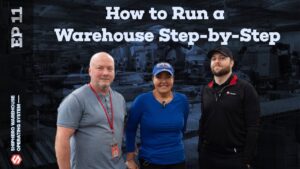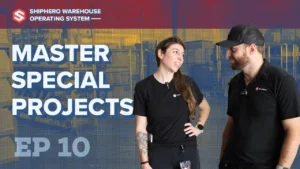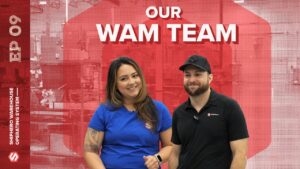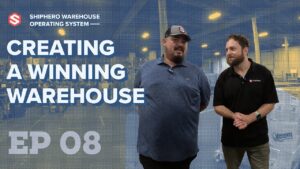Are you curious about the inner workings of an inbound warehouse?
How do they keep production running smoothly and efficiently?
Aaron visits ShipHero’s Las Vegas warehouse and speaks with Inbound Manager Tomasi Manuatu to get the inside scoop on receiving inbound processes and all the industry acronyms. Don’t miss this exclusive interview!
Video Transcript
- Hey Tomasi. So you're the outbound manager here at our Las Vegas facility
- Inbound manager, so what I do--
- Let's start over. Tomasi, Inbound Manager, Las Vegas facility. What does that mean, what's your role?
- So what we do is we do the day-to-day operations and receiving. So anything that comes in for trucks, basically receive it, make sure it gets its license plate number. Then it goes to one of our overstock locations, whether it B, C, D. From there it triggers replen and then we replenish the product. A little bit of what else we do is load balance as well. So we send out to our other facilities, balance out our inventory.
- Let's talk about the lifecycle. Let's talk about the process, when a, what we call an SP, shipping plan, people call 'em purchase orders. So purchase order is created by the customer. There's a date scheduled. The inbound team books an appointment for when it's gonna show up, right? Then it shows up at the dock. Then your team gets involved, right?
- Yes, so basically what would happen is we have the shipping plans, purchase orders that come in. That come hit our docks. As soon as they hit our docks, we open these purchase plans and then we basically go from looking and seeing what product we have, how many we have back order, whatever the case may be for that specific shipping plan. We basically receive the stock in, make sure whether it's allocated to the RSP, RSC, whatever receiving stores location that we have. And then from there we put into overstock. It's a sellable location so that now it triggers and allocates orders so that we can get it replenished.
- Yeah, so let's break it down. Let's go a little slower. So product shows up. First, we make sure it's the right product.
- Yes.
- Phase one. Phase two, the system tells us how many we wanna receive in this building and how many we wanna cross dock to other building.
- A hundred percent.
- Right?
- Yes.
- So once we do that, the inbound product, for the most part that goes to overstock. We don't take new product and put it directly on the pickable shelves. We put 'em into sellable, but unpickable locations in the
- Overstock location
- That's step one?
- Yeah, step one yep.
- And then how do we know, how does your team know to take some of that stock from the pallet racks and put it in the pickable shelves?
- So that will then trigger a replenishment. So you can do it one of two ways. Once we get the shipping plan, we can look and see what's back ordered and then from there we can know like, okay we're gonna move these RSPs, RSCs, whatever they are strictly straight into a pickable location.
- Got it, so, if a PO shows up or an SP shows up, and you have a backorder for let's say 20 units, instead of putting it in overstock and then waiting for the replenishment report to tell you to put it away there, you'll just take 20, or maybe you'll take 40 'cause you know you're gonna need more and put it straight in pickable and then take the other ones and tag them to go up into the dock, into the,
- Overstock location.
- Overstock locations. And then when you think about how to divide your team, so you got receiving, load balance, which is both load balancing off of SPs that came in as well as pulling from the shelves.
- Pulling from the shelves.
- You've got inventory control, you got replen, where you gotta stock the the pickable shelves for the pickers. How do you think about limited number of people, some days are busy. How do you manage that?
- So basically what I'll do is I'll just plan the day out. Like if I know on our calendar, we have a Google calendar which tells us what freights we got coming. So I'll look at that and see through the day, through the week, through the month and just kind of play it by that. See what we have coming in, how many people I know I'm gonna have in receiving, then how many tur operators I'm gonna have to put these into overstock locations. So it all depends 'cause sometimes we could walk in replenishment a lot. Replenishment might not be a lot one day, but we might have a lot of receiving. So it's kind of like delegating everybody into those different types of departments I guess you could say in inbound where it's like, okay you're gonna work on load balance today. We need to get a truck out to ABE this Friday, or whatever the case may be. So it's really just delegating the employees in the inbound to make sure that we have enough everywhere.
- And how do you think about what you wanna do during first shift versus the second shift?
- So my biggest goal, like when I get in is everything that we got coming in, I wanna receive it. I wanna make sure that it has a license plate number whether it or staging location and then we get it up into the racks just so that all the orders, whatever orders we have backorders can allocate for those. And we get the replen and get it all out the door. 'Cause the main goal is to make sure that outbound is moving. So whatever we get in, I wanna make sure we're proactively looking at it like, okay, we got these backorders. We need to make sure that we put these products out so that we can get the pickers to pick 'em and then we just keep stocking it through.
- And normally if pickers say that they're not pulling up orders, we always say it's probably your fault.
- It's probably replen, yep, a hundred percent. So I literally, so we have a thing here where it's like I tell Ryan all the time if the pickers are telling us we that we're not pulling the orders or he's telling me that I know it's a replen. So the biggest thing for me is to make sure that I always look at anything that's coming in on SPs that we have that. And then as far as replenishment goes, we always just try to keep it under 10 and make sure that we're cruising through it.
- Yeah, constantly feeding the, the outbound machine
- A hundred percent, a hundred percent.
- All right, what is, I know things don't always go perfect. So what are the biggest problems that you face in your role?
- Biggest problem might be something might come in noncompliant and it may, as soon as they hit it to our dock, we might get some of it in and then it's like it'll allocate the orders, but we still receive some other stuff. But some of the stuff might be noncompliant. Sit in, we gotta wait to make sure we're reaching out to the customer through our WAM and getting that situated and then those might sit for maybe a day, maybe a week. We don't really know. So a lot of that is a little bit of frustration 'cause it's like when you get something in, you want to get it going. You wanna get it off your dock. So it's like my biggest goal is always make sure the docks is empty. Whatever's on the dock it's accounted for.
- Right. Okay, so you sort of halfway through, you try to scan something. Doesn't scan or it's damaged or it doesn't match the SP. So then you gotta pause. And you got all this stock on the dock. The WAMs are warehouse account manager. You ask him or her to like, hey, talk to the customer.
- See what's going on.
- See what's up. Tell me what to do. And then the product's still sitting on the dock at that point, right? At what point do you say it's been a while. I need to get, I need this lane, I need this dock space. I'm gonna move this somewhere else, tag it as noncompliant so I get my dock space back?
- So we basically got like four flex zones next to our receiving area so that we put our non-compliant there. So whether it sits longer than two, I give it two days. If it sits longer than two days on a dock, I move it straight over to our flex zones, which are non-compliant zones. Then I'm kind of relying on our receiving team, myself as well, to make sure that we're reaching out, following up. Hey just a courtesy follow up, what's going on with this? Just to make sure it doesn't sit in that non-compliance zone longer than it needs to be.
- What's your favorite feature in ShipHero?
- The hospital. It it, you know like when a picker goes to a location they flag it. So when they flag it it's our job to go figure out what's wrong with it. So we'll go there, we'll visit. we'll do two maybe a, a few things. We'll scan the product, make sure the product scans, see we'll count it, make sure we'll either pick or flag it. 'cause they could've flagged for numerous reasons. The barcode doesn't scan, it's not enough in the location. Maybe need a replen that we didn't get to fast enough. So I think the hospital is good 'cause it proactively lets us know keeps the team on their feet where they're like, okay we need to go for action these locations and make sure they become pickable again. 'cause as you know, if you flag the location, it becomes non pickable.
- So yeah, no other pickers get sent there which means orders can wait if they're, that's the only place the product is.
- Yep, a hundred percent.
- What have you learned recently that's helped you do your job better?
- It's really a mixture thing, I think. So load balance has helped a lot. I think I've spent more time with the load balance team within the last month or two. Really just diving in with that and figuring out how can we get these load balance from our dock straight to our overstock location or pickable locations
- So I'm at the inbound load balance. So we get a truck from ABE and you want to get that on the shelf without any work.
- Any work, yeah. So it, so like you do have your pros and cons with it, but the biggest thing I think is like it makes it so much easier just to literally just scan from one point and then scan right back into your pickable location. You know, so it makes it a lot easier for us to move the product. Like we're not having to receive anything really. We're just really, boom, it's in our system. Boom, it goes to a pickable location.
- Even though it's from one building to another it's actually just an inventory transfer.
- Yep, yep.
- All right, perfect. So it's been a year that you've been here. What's the evolution been like?
- When I first got here, I'm gonna be really honest with you. When I got here, everybody was kind of working anywhere. There was no designated areas. So when we got here, it was me and when Ryan got here it's really just delegating the fact of making sure that we had this approach where it was like we're gonna designate these areas for certain things. We're gonna clean up our dock. We're gonna put our shelving up, make sure these customers have their inventory here, certain places, you know. So a lot has changed. I think the biggest thing is getting the inventory corrected, cycle counting the building our full audit and really just taking ownership of our inventory. I think that was the thing that I was kind of pulling teeth with when I first got here. It was like trying to figure out what do we have here in the building. And to say a year from now till now, it's like we've came a long way. I can actually say like if I send someone to a location, I know some, I know it's there, you know?
- So good inventory visibility.
- Yeah, a hundred percent.
- So what do you, what do you wanna see improve from now till a year from now?
- Honestly, just start, just continue to build off of what we got going here. I think the biggest thing is we're making strides and making room for everything. So we have a lot more customers we're planning to get in so I wanna make sure that we have the capacity to have that like we're getting containers left and right. So really just building off of keeping our inventory accurate and then having that space to always keep the customers bringing their product in.
- And if you can help train a new person stepping into the the role of inventory manager for the first time or inbound manager for the first time, what would you tell 'em?
- I would tell 'em keep a level head and continue to just work through it. Inventory never ends so you're not gonna get it all in one shot. So it's something that, it's steady evolving. It's always something new. So just keep a level head and just continue to work at it. And it's honestly, it's really like a competition really with yourself, trying to make sure that every day you're gonna find something new. Every day things might not go the way they did yesterday. So just keep a level head. That's what I say.
- And the building's definitely improved in the time. You've been here, Ryan's been here. I think the team solidified, we've got some good stability and we've got some really good team members and the results show. Thank you, you're doing great.
- Thank you.
- Appreciate it.



